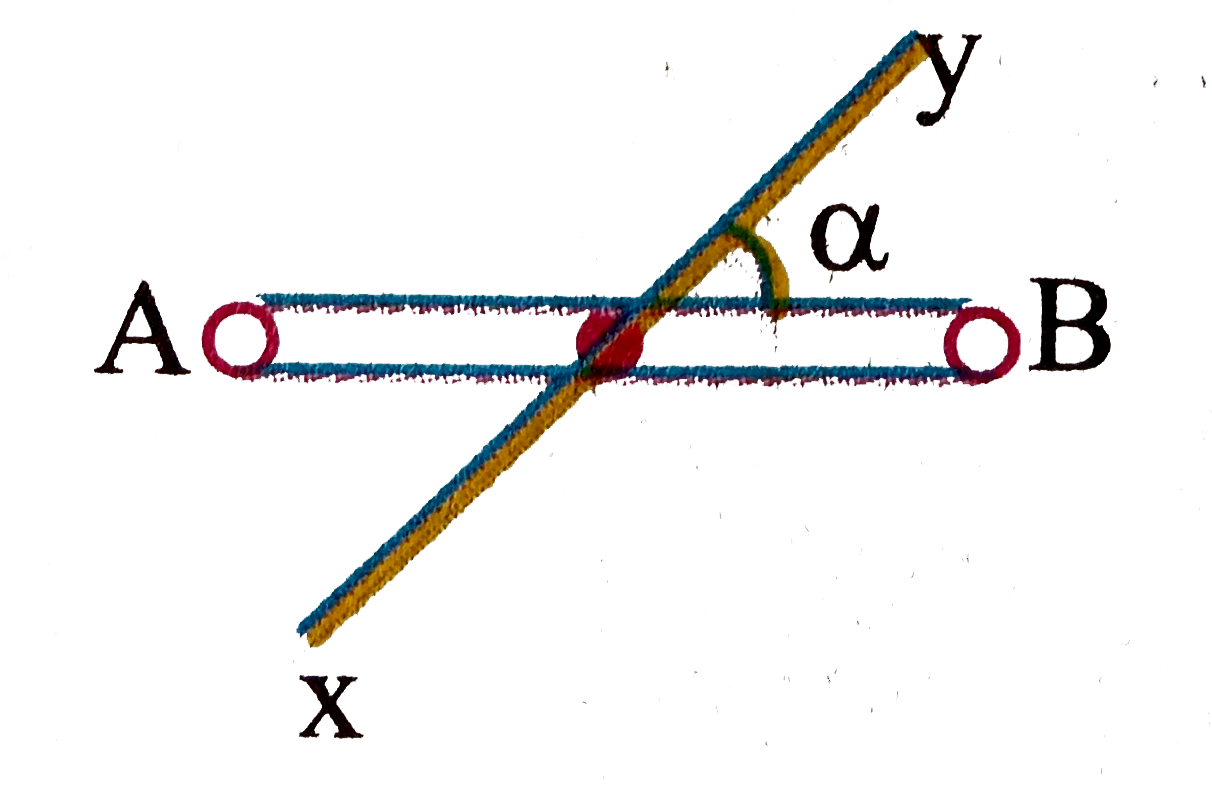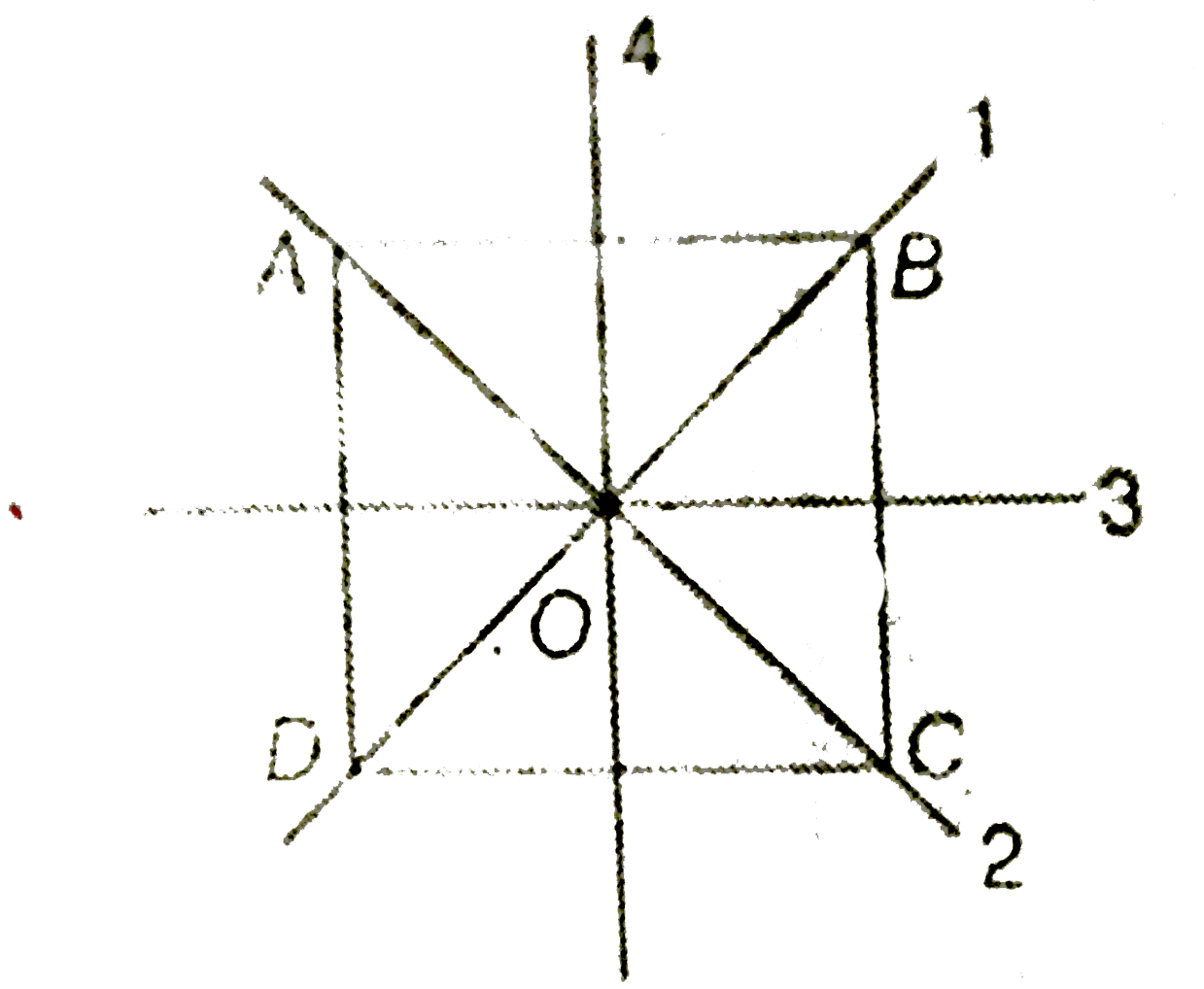Let l be the moment of inertia of a uniform square plate about an axis AB that passes through its centre and is parallel to two of its sides. CD is a line in the plane of the plate that passes through the centre of the plate and makes an angle θ with AB. The moment of inertia of the plate about the axis CD is then equal to
(a)I0
(b)I0cosθ
(c)I0cos2θ
(d)None of these
To find the moment of inertia of a uniform square plate about an axis CD that passes through its center and makes an angle θ with the axis AB, we can use the perpendicular axis theorem and properties of symmetry. Here’s the step-by-step solution:
Step 1: Understand the Configuration
- Let the moment of inertia of the square plate about the axis AB (which is parallel to two sides of the square) be denoted as IAB.
- The axis CD makes an angle θ with the axis AB and also passes through the center of the plate.
Hint: Visualize the square plate and the axes to understand their orientations.
Step 2: Apply the Perpendicular Axis Theorem
- According to the perpendicular axis theorem, for a planar object, the moment of inertia about an axis perpendicular to the plane (let's call it Iz) is the sum of the moments of inertia about two perpendicular axes lying in the plane of the object:
Iz=Ix+Iy
- Here, we can consider IAB as Ix and IA′B′ (the moment of inertia about the axis perpendicular to AB) as Iy.
Hint: Remember that for symmetrical shapes, the moments of inertia about axes that are symmetrical are equal.
Step 3: Use Symmetry
- For a uniform square plate, the moment of inertia about the axes AB and A'B' will be equal due to symmetry:
IAB=IA′B′
- Thus, we can express the total moment of inertia as:
Iz=IAB+IAB=2IAB
Hint: This step relies on the symmetry of the square plate.
Step 4: Relate Moments of Inertia
- Now, we can express the moment of inertia about the axis CD using the relationship established by the perpendicular axis theorem:
ICD=IABcos2(θ)+IA′B′sin2(θ)
- Since IAB=IA′B′, we can simplify this to:
ICD=IAB(cos2(θ)+sin2(θ))=IAB
Hint: Use the trigonometric identity cos2(θ)+sin2(θ)=1.
Step 5: Final Calculation
- From the previous steps, we know that:
ICD=IAB
- If we denote the moment of inertia about AB as I, then:
ICD=I
Hint: Ensure you are consistent with the notation used for the moment of inertia.
Conclusion
The moment of inertia of the uniform square plate about the axis CD is equal to I, which is the same as the moment of inertia about the axis AB.
Final Answer: ICD=I
- Let the moment of inertia of the square plate about the axis AB (which is parallel to two sides of the square) be denoted as IAB.
- The axis CD makes an angle θ with the axis AB and also passes through the center of the plate.
- According to the perpendicular axis theorem, for a planar object, the moment of inertia about an axis perpendicular to the plane (let's call it Iz) is the sum of the moments of inertia about two perpendicular axes lying in the plane of the object:
Iz=Ix+Iy
- Here, we can consider IAB as Ix and IA′B′ (the moment of inertia about the axis perpendicular to AB) as Iy.
- For a uniform square plate, the moment of inertia about the axes AB and A'B' will be equal due to symmetry:
IAB=IA′B′
- Thus, we can express the total moment of inertia as:
Iz=IAB+IAB=2IAB
- Now, we can express the moment of inertia about the axis CD using the relationship established by the perpendicular axis theorem:
ICD=IABcos2(θ)+IA′B′sin2(θ)
- Since IAB=IA′B′, we can simplify this to:
ICD=IAB(cos2(θ)+sin2(θ))=IAB
- From the previous steps, we know that:
ICD=IAB
- If we denote the moment of inertia about AB as I, then:
ICD=I
The moment of inertia of the uniform square plate about the axis CD is equal to I, which is the same as the moment of inertia about the axis AB.
Topper's Solved these Questions
- ROTATIONAL MECHANICSBOOK - DC PANDEY ENGLISHCHAPTER - ROTATIONAL MECHANICSEXERCISE - Level 1 Subjective
32 Videos
- ROTATIONAL MECHANICSBOOK - DC PANDEY ENGLISHCHAPTER - ROTATIONAL MECHANICSEXERCISE - Level 2 Single Correct
26 Videos
- ROTATIONAL MECHANICSBOOK - DC PANDEY ENGLISHCHAPTER - ROTATIONAL MECHANICSEXERCISE - Assertion And Reason
11 Videos
- ROTATIONBOOK - DC PANDEY ENGLISHCHAPTER - ROTATIONEXERCISE - (C) Chapter Exercises
39 Videos
- ROTATIONAL MOTIONBOOK - DC PANDEY ENGLISHCHAPTER - ROTATIONAL MOTIONEXERCISE - Integer Type Questions
17 Videos
Similar Questions
The moment of inertia of a copper disc, rotating about an axis passing through its centre and perpendicular to its plane
View SolutionFind the moment of inertia of a uniform square plate of mass M and edge a about one of its diagonals.
View SolutionFind the moment of inertia of a uniform square plate of mass M and edge a about one of its diagonals.
View SolutionThe moment of inertia of a uniform rod of length 2l and mass m about an axis xy passing through its centre and inclined at an enable α is

View SolutionThe moment of inertia of a cube of mass M and edge length a about an axis passing through one of its edge is
View SolutionThe moment of inertia of a thin square plate ABCD of uniform thickness about an axis passing through the centre O and perpendicular to plate is

View SolutionMoment of inertia of a ring of mass M and radius R about an axis passing through the centre and perpendicular to the plane is
View SolutionCalculate the moment of inertia of a ring of mass 2kg and radius 2cm about an axis passing through its centre and perpendicular to its surface.
View SolutionCalculate the moment of inertia of a ring of mass 2kg and radius 2cm about an axis passing through its centre and perpendicular to its surface.
View SolutionMoment of inertia of a uniform quarter disc of radius R and mass M about an axis through its centre of mass and perpendicular to its plane is :
View Solution
